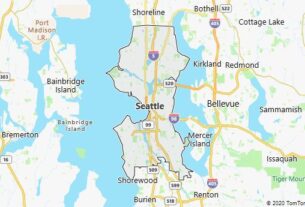Demographic conditions. – The census of January 1970 found a population of 48,225,238 residents, With an average density of 25 residents per km 2.
It is estimated that in 1975 the population exceeded 60 million residents: the rate of increase is very high (around 35 ‰), due to the high birth rate (reduced, however, from 43.4 ‰ in 1970 to 35.7 ‰ in 1975) and due to the further curbing of the mortality rate, especially infants, which fell below 7%, while emigration had little impact after the blockade of the entry of Mexican laborers ordered in 1964 by the United States. The increase was different in the various states: in fact in the decade 1960-70 the population doubled, and in some cases even more, in most of them (especially in those of the North Pacific, the Center and the Gulf of Mexico) and it quadrupled in Baja California and Quintana Roo. With the increase of the population this
According to shoefrantics, the distribution of the population is also very varied, with a strong increase in the urban one (in centers of over 2500 residents), equal to 62.8% of the total in 1975 (against 44.4% in 1957), with the increase in the number of cities with over 100,000 residents (37 in 1975 against 17 of 15 years earlier) and with the spectacular increase of some of them and first of all of the capital, Mexico City, which jumped in 1975 to 8,591,000 residents (11,339,774 in the urban agglomeration, 4th in the world); two other cities, Guadalajara and Monterrey, have more than one million residents, and two (Ciudad Juárez and León) have more than half a million.
Economy. – The progressive, notable evolution of the socio-economic structure of Mexico, which is “the most advanced of the developing countries”, caused a contraction of the active population, which dropped to 27% of the total in 1975 (against 32, 4% of 1960), and the modification of the professional structure which in 1970 counted about 45% of employees in the primary sector, 23% in industries and 32% in the tertiary sector, against 54%, 19% respectively. and 26.2% in 1960. In fact, today Mexico has a diversified economy which has had a strong increase in prod. nat. gross until 1970 (7-8% per annum, the highest in Latin America), whose expansion has halved since 1971 with the serious crisis following the “desarrollo estabilizados”. Agriculture, although it is the most practiced activity, jornaleros) without land; the excessive extension taken by the scarcely profitable mini-fund, the slowdown in irrigation (3.2 million ha), the cultivation of new land and financing.
To obviate these serious structural defects and with the affirmation of the “agrarian” thesis over the “productivist” one, the 1972 law provided for the “reform of the reform” based on the strengthening of collective eijdos and cooperativism, together with the provisions for incentives concerning: the spread of agricultural techniques, the development of the production and consumption of fertilizers, the increase in agricultural credit and the improvement of irrigation.
However, in the four-year period 1968-72, the production of cereals, which more than doubled in the previous decade, suffered a stagnation which was then only partially overcome. Among the crops destined for export, sugar cane has developed well (due to the blockade of imports from Cuba implemented by the United States), which in 1974 gave over 28 million q of sugar (compared to 8 million q in 1955), coffee (about 2.4 million q, half exported) and citrus fruits (over 31 million q); on the other hand, cotton is declining. Cattle breeding (bovine species with 28 million head in 1975, and pig) and even more fishing (500,000 t) practiced in the Gulf of California (new fishing port of Guaymas in Sonora) and in Yucatán (Ciudad del Carmen). L’ industry has made important progress due to the increase in public investment and private consumption, and due to substantial foreign investment, for three quarters from the United States. The mining activity has had a notable increase, even with economic downturns. The extraction of iron ores (over 3 million tonnes of ore also for the exploitation of the Las Truchas deposits, in Michoacán), of coal (over 5 million tonnes, with lignite, mainly due to progress of the steel industry), sulfur and copper. Important progress has also been made in the energy sector, with the sharp increase in the extraction of oil (over 37 million tonnes, including from the new Chiapas basin, partly submarine) and natural gas (22 billion tonnes).3). The production of electricity has also increased (43 billion kWh of which 17 are water and partly geothermal from the Cerro Prieto power plant), for which a large nuclear power plant is about to come into operation. Even more important have been the progress of industries, favored by widespread tariff protectionism; among the basic ones the metallurgical ones stand out (especially the steel industry with over 3 million t of cast iron and ferroalloys and 5 million t of steel, with the modern large complex of Las Truchas integrated with the new port of Lazzaro Cárdenas, at the mouth of the Balsas), and the petrochemicals in the hands of PEMEX (Petroleos Mexicanos) which has also greatly developed the production of synthetic ammonia and fertilizers. Also noteworthy is the increase in cement production (12.5 million t), which has quintupled in the last 20 years. Over half of industrial production is made up of manufacturing industries which have diversified widely and supply railway material, motor vehicles, household appliances, chemicals, food and textiles. But for the most part they are in the hands of multinationals, especially in the chemical, food and mechanical sectors. The sharp increase in the import of capital goods and raw materials for industry as well as consumer goods, together with the persistent prevalence of exports of primary agricultural products (sugar, coffee, fibers, livestock) and mining products with prices subject to the world market, it made the foreign trade deficit increasingly serious in the five-year period 1971-75; from 11.5 to 46.5 billion pesos, with a sharp surge in 1974, when imports rose to 75.
Another factor of imbalance is the excessive polarization of trade, two thirds of which are now exchanged with the USA and then with the countries of the ECSC (especially with the Federal Republic of Germany) and with those of the ALCA (Latin Association). American Free Trade). But the large deficit is largely filled by capital movements, by the favorable balances of border transactions and by tourism: the latter, in particular, has taken on great importance (3.7 million tourists in 1974, mainly from the United States) and has gave birth to large centers including well known Acapulco, Cuernavaca and Veracruz.
Tourism and internal traffic are favored by the development of the road network (154,520 km in 1975) and motorway which has the Pan-American road as its axis, from the border with the USA, to Ciudad Juárez, to that with Guatemala, for 10,283 km; the merchant fleet (575,000 t in 1975) also had considerable development, especially as regards oil tankers.
And economy. – The Mexican economy reflects the geographical position of the country, a bridge between the United States of America and South America. The industrial sector, in fact, has developed very rapidly thanks mainly to US investments, while the agricultural sector still retains largely the structures of underdeveloped countries.
National income grew, in real terms, at an average rate of 6.75% in the fifteen-year period 1960-75, passing from 212.5 to 529.5 million pesos (1970 prices). The development of income was accompanied, up to the end of the 1960s, by substantial price stability; in the subsequent period, on the contrary, inflation became a worrying phenomenon, which reached its peak in 1974 when consumer prices increased by 22.4%. Since 1975, therefore, the Mexican government’s policy has been characterized by an attempt to bring the inflationary process under control, both by containing the expansion of the monetary base and by restricting credit to the private sector. At the same time, efforts were made to encourage the inflow of new capital from
Mexican foreign trade takes place mainly with the United States, to which it mainly exports manufactured products.
The trade balance has a chronic deficit, the amount of which has increased further from 1970 onwards. This deficit is offset by the considerable inflow of foreign capital, of essentially North American origin. The recent discovery of vast oil fields, however, gives hope that the trade deficit can be reabsorbed within a short time, even if the extraction of crude oil is still far from expected levels.



